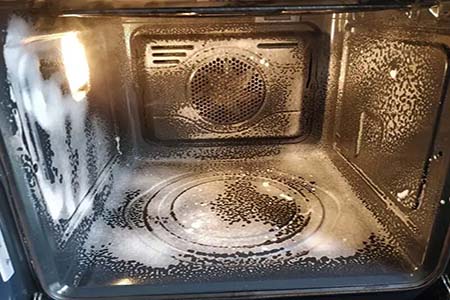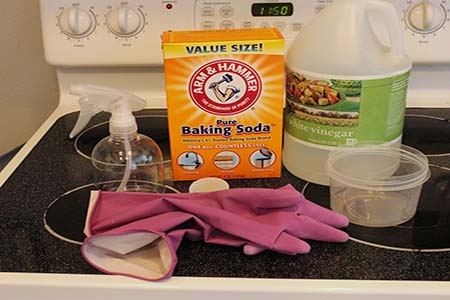Cleaning your oven is a routine household chore, but what do you do when you find a mysterious white residue in oven after cleaning efforts? This common issue can be frustrating, but understanding its causes and effective solutions can help you achieve a sparkling clean oven. In this comprehensive guide, we’ll explore the reasons behind white residue buildup, how to diagnose the issue, and practical ways to remove it.
Common Causes of White Residue
When you open your oven after cleaning or cooking, encountering white residue can be a perplexing sight. Understanding the potential causes behind this issue is the first step in effectively addressing it. Several factors can contribute to the formation of white residue in your oven:
1. Leftover Cleaning Agents: One of the primary reasons for white residue in your oven is the presence of leftover cleaning agents. Even after a thorough cleaning, remnants of cleaning sprays or solutions may linger on oven surfaces. These residues can dry out and leave behind unsightly white streaks when the oven is heated.
2. Hard Water Deposits: If you live in an area with hard water, it contains minerals like calcium and magnesium. When hard water evaporates on oven surfaces, it can deposit these minerals as a white, chalky residue. Over time, this buildup can accumulate and become more visible.
3. Residue from Burnt Food: Spills and food remnants that are burnt onto oven surfaces can also result in white residue. When these food particles burn, they release minerals that settle as a white film when they cool down. This residue can be particularly stubborn if not addressed promptly.
4. Incorrect Cleaning Techniques: Using improper cleaning techniques or abrasive scrubbers can contribute to white residue formation. Harsh cleaning methods can damage oven surfaces, making them more prone to residue buildup. Additionally, if cleaning products are not rinsed thoroughly, they can leave behind residue when the oven is used.
Diagnosing the Issue
When you encounter white residue in your oven, it’s essential to determine the root cause to effectively address and prevent its recurrence. Diagnosing the issue involves a series of observations and tests to pinpoint the source of the white residue. Here’s a step-by-step guide to help you diagnose the problem:
1. Visual Inspection
Begin by visually examining the interior of your oven, paying close attention to areas where white residue is present. Take note of the following:
- Location: Determine if the residue is concentrated in specific areas, such as the oven door, racks, or heating elements.
- Extent: Note the extent of the residue. Is it a few isolated spots, streaks, or widespread coverage?
- Texture: Observe the texture of the residue. Does it appear powdery, gritty, or crystalline in nature?
Visual inspection provides crucial information about the appearance and distribution of the white residue, which can help identify its origin.
2. The Touch Test
Gently touch the white residue with a gloved hand or a clean cloth. Pay attention to how it feels:
- Gritty or Powdery: If the residue feels gritty or powdery to the touch, it might be mineral-based, such as hard water deposits.
- Smooth or Sticky: A smooth or sticky texture may indicate leftover cleaning agents or food-related residue.
The tactile feedback from the touch test can provide additional clues about the nature of the residue.
3. Understanding the Residue’s Location
Consider where the white residue predominantly accumulates within the oven. Understanding its location can help narrow down the potential causes:
- Oven Door: If the residue is primarily on the oven door’s glass or seals, it could be due to cleaning agents or spills during cooking.
- Heating Elements: Residue on heating elements may result from burnt-on food particles.
- Racks and Interior Surfaces: Widespread residue on racks and interior surfaces may be related to hard water deposits.
Solutions for Removing White Residue
1. Natural Cleaning Agents
For gentle yet effective cleaning, consider using natural cleaning agents that are safe for your oven’s surfaces. Some options include:
- Vinegar: Mix equal parts white vinegar and water to create a non-abrasive cleaning solution. Apply it to the affected areas and let it sit for a few minutes before wiping with a cloth or sponge. Rinse thoroughly.
- Lemon Juice: Lemon juice has natural acidic properties that can help dissolve white residue. Apply fresh lemon juice to the affected areas, let it sit for a few minutes, and then scrub gently before rinsing.
- Baking Soda: Create a paste by mixing baking soda with water. Apply the paste to the residue, allow it to sit for a couple of hours, and then scrub with a non-abrasive sponge or cloth. Rinse thoroughly.
2. Commercial Oven Cleaners
Commercial oven cleaners are formulated to tackle tough residues. When using these products, follow the manufacturer’s instructions carefully. Ensure proper ventilation by opening windows or using exhaust fans, as some oven cleaners can emit strong fumes.
3. Vinegar and Baking Soda Method
This combination of vinegar and baking soda can be highly effective:
- Start by applying a thin layer of baking soda to the white residue.
- Spritz the baking soda with a mixture of equal parts white vinegar and water. This will create a bubbling reaction that helps break down the residue.
- Allow the mixture to sit for a few hours or overnight.
- Scrub the affected areas gently with a non-abrasive sponge or cloth.
- Rinse thoroughly to remove any remaining residue.
4. Proper Cleaning Techniques
When cleaning your oven, use proper techniques to ensure effective residue removal:
- Use gentle scrubbers, such as soft brushes or non-abrasive sponges, to avoid damaging oven surfaces.
- Ensure that cleaning products are rinsed off completely to prevent any leftover residues.
- Pay special attention to areas where residue tends to accumulate, such as around the oven door or heating elements.
By employing these solutions and cleaning techniques, you can effectively remove white residue from your oven and restore its cleanliness.
Dealing with Stubborn Residue
While many cases of white residue in ovens can be effectively resolved using the solutions mentioned earlier, some situations may involve particularly stubborn or persistent residue. In such cases, you may need to employ alternative methods and consider seeking professional assistance. Here’s how to deal with stubborn residue:
When Natural Methods Fail
If your attempts to remove white residue using natural cleaning agents like vinegar, baking soda, or lemon juice prove unsuccessful, it’s time to explore other options:
- Commercial Oven Cleaner: Consider utilizing a commercial oven cleaner that is specifically engineered to tackle persistent residue. These cleaning solutions are specially designed to dissolve stubborn stains and buildup. It is important to diligently adhere to the manufacturer’s instructions and ensure adequate ventilation while using the product.
- Heat Cleaning: Some ovens have a self-cleaning function that uses high heat to burn off residue. Refer to your oven’s manual for instructions on how to activate this feature safely. Keep in mind that this method may produce strong odors and smoke, so adequate ventilation is essential.
Seeking Professional Help
If you’ve exhausted your cleaning efforts, and the stubborn residue remains, it may be time to consult a professional oven cleaning service. Professional technicians have the expertise, specialized equipment, and cleaning solutions necessary to tackle even the most stubborn oven residues.
Professional oven cleaning offers several advantages:
- Thorough Cleaning: Technicians can disassemble and clean individual components of your oven, ensuring a comprehensive cleaning process.
- Safe Handling: Professionals are trained to handle cleaning agents and residues safely, minimizing any risks associated with harsh chemicals.
- Preventative Maintenance: In addition to cleaning, technicians can inspect your oven for potential issues and offer maintenance recommendations to prevent future residue buildup.
Remember that professional cleaning services may come with a cost, but they can be a valuable investment in maintaining the condition and longevity of your oven.